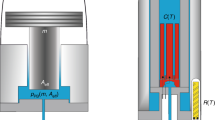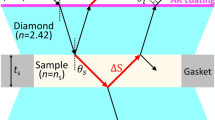Abstract
EXPERIMENTS have recently been performed in which the effects of pressure on the electrical properties of ice were studied. The stress applied was compression between two plates which formed the measuring capacitor. Samples measured included a polycrystalline specimen having coarse- and fine- grained structure and single crystals cut parallel to, perpendicular to, and at 45° to the c-axis. The stress was a static compression of about 2 kgm./cm.2 applied at the start of each measurement. The sample holder was connected to a G.R. 816-C radiofrequency bridge which was balanced at 1 kc. before the load was applied. An oscilloscope was used as an indicator. The sample was then loaded and the oscilloscope deflexion was observed as a function of the time. The bridge was rebalanced at the end of each run. Since the balance is extremely sensitive to temperature fluctuations, special precautions had to be taken.
This is a preview of subscription content, access via your institution
Access options
Subscribe to this journal
Receive 51 print issues and online access
$199.00 per year
only $3.90 per issue
Buy this article
- Purchase on Springer Link
- Instant access to full article PDF
Prices may be subject to local taxes which are calculated during checkout
Similar content being viewed by others
References
Jellinek, H. H. G., and Brill, R., J. App. Phys., 27, 1198 (1956).
Author information
Authors and Affiliations
Rights and permissions
About this article
Cite this article
BRILL, R., CAMP, P. Influence of Pressure on the Dielectric Properties of Ice. Nature 179, 623–624 (1957). https://doi.org/10.1038/179623c0
Issue Date:
DOI: https://doi.org/10.1038/179623c0
This article is cited by
-
Properties and lattice imfections of ice crystals and the behaviour of H2O-HF solid solutions
Physik der Kondensierten Materie (1962)
Comments
By submitting a comment you agree to abide by our Terms and Community Guidelines. If you find something abusive or that does not comply with our terms or guidelines please flag it as inappropriate.



